Design of Single-Mode Single-Polarization Large-Mode-Area Multicore Fibers
Abstract
:1. Introduction
2. Structure and Theory
2.1. Designof the Single-Mode Single-Polarization Large-Mode-Area Multicore Fiber
2.2. Theoretical Description
2.3. Optimization Framework
3. Results and Discussion
4. Conclusions
Author Contributions
Funding
Data Availability Statement
Conflicts of Interest
Appendix A
| #1 | #2 | #3 | #4 | #5 | #6 | #7 | #8 | #9 | #10 | #11 | #12 | #13 | #14 | #15 | #16 | #17 | #18 | #19 | #20 | #21 | |
|---|---|---|---|---|---|---|---|---|---|---|---|---|---|---|---|---|---|---|---|---|---|
| 0.13 | 0.13 | 0.11 | 0.18 | 0.16 | 0.15 | 0.14 | 0.15 | 0.15 | 0.15 | 0.13 | 0.11 | 0.15 | 0.11 | 0.14 | 0.17 | 0.1 | 0.13 | 0.15 | 0.13 | 0.1 | |
| 0.15 | 0.18 | 0.16 | 0.16 | 0.15 | 0.17 | 0.18 | 0.12 | 0.15 | 0.14 | 0.14 | 0.14 | 0.18 | 0.17 | 0.19 | 0.18 | 0.17 | 0.15 | 0.18 | 0.16 | 0.19 | |
| 0.16 | 0.17 | 0.16 | 0.21 | 0.18 | 0.18 | 0.17 | 0.18 | 0.19 | 0.17 | 0.19 | 0.17 | 0.19 | 0.18 | 0.15 | 0.19 | 0.17 | 0.18 | 0.21 | 0.14 | 0.14 | |
| 0.15 | 0.14 | 0.11 | 0.15 | 0.14 | 0.16 | 0.14 | 0.15 | 0.12 | 0.14 | 0.15 | 0.12 | 0.16 | 0.14 | 0.12 | 0.12 | 0.12 | 0.13 | 0.14 | 0.13 | 0.14 | |
| 0.15 | 0.15 | 0.1 | 0.19 | 0.14 | 0.18 | 0.13 | 0.15 | 0.14 | 0.14 | 0.14 | 0.12 | 0.15 | 0.16 | 0.17 | 0.13 | 0.14 | 0.11 | 0.16 | 0.12 | 0.11 | |
| 0.14 | 0.15 | 0.13 | 0.14 | 0.13 | 0.13 | 0.16 | 0.16 | 0.17 | 0.14 | 0.15 | 0.13 | 0.13 | 0.12 | 0.14 | 0.16 | 0.15 | 0.14 | 0.16 | 0.16 | 0.15 | |
| 0.17 | 0.15 | 0.14 | 0.15 | 0.13 | 0.13 | 0.16 | 0.14 | 0.14 | 0.15 | 0.16 | 0.17 | 0.14 | 0.18 | 0.1 | 0.12 | 0.13 | 0.19 | 0.16 | 0.15 | 0.16 | |
| 0.14 | 0.13 | 0.13 | 0.18 | 0.16 | 0.17 | 0.12 | 0.17 | 0.13 | 0.14 | 0.11 | 0.13 | 0.12 | 0.12 | 0.16 | 0.11 | 0.15 | 0.12 | 0.13 | 0.14 | 0.11 | |
| 0.14 | 0.12 | 0.12 | 0.17 | 0.12 | 0.14 | 0.12 | 0.11 | 0.14 | 0.14 | 0.13 | 0.16 | 0.11 | 0.16 | 0.11 | 0.15 | 0.13 | 0.14 | 0.16 | 0.13 | 0.11 | |
| 0.17 | 0.17 | 0.12 | 0.15 | 0.18 | 0.13 | 0.16 | 0.17 | 0.16 | 0.16 | 0.13 | 0.13 | 0.17 | 0.12 | 0.15 | 0.18 | 0.13 | 0.17 | 0.15 | 0.17 | 0.17 | |
| 0.18 | 0.18 | 0.2 | 0.2 | 0.18 | 0.2 | 0.17 | 0.21 | 0.17 | 0.17 | 0.18 | 0.15 | 0.19 | 0.14 | 0.18 | 0.15 | 0.18 | 0.17 | 0.18 | 0.15 | 0.15 | |
| 0.13 | 0.15 | 0.16 | 0.18 | 0.16 | 0.17 | 0.14 | 0.15 | 0.16 | 0.15 | 0.16 | 0.17 | 0.13 | 0.16 | 0.14 | 0.14 | 0.17 | 0.19 | 0.22 | 0.18 | 0.12 | |
| 0.12 | 0.15 | 0.13 | 0.19 | 0.13 | 0.18 | 0.14 | 0.15 | 0.14 | 0.14 | 0.15 | 0.13 | 0.17 | 0.17 | 0.14 | 0.16 | 0.13 | 0.13 | 0.16 | 0.15 | 0.12 | |
| 0.18 | 0.15 | 0.13 | 0.14 | 0.16 | 0.15 | 0.12 | 0.16 | 0.14 | 0.15 | 0.13 | 0.13 | 0.12 | 0.12 | 0.12 | 0.16 | 0.16 | 0.12 | 0.14 | 0.15 | 0.16 | |
| 0.16 | 0.18 | 0.18 | 0.19 | 0.17 | 0.17 | 0.19 | 0.16 | 0.18 | 0.19 | 0.19 | 0.18 | 0.18 | 0.18 | 0.14 | 0.17 | 0.19 | 0.2 | 0.17 | 0.18 | 0.2 | |
| 0.1 | 0.16 | 0.17 | 0.14 | 0.16 | 0.15 | 0.16 | 0.15 | 0.12 | 0.14 | 0.13 | 0.15 | 0.14 | 0.13 | 0.13 | 0.11 | 0.16 | 0.14 | 0.17 | 0.13 | 0.13 | |
| 0.17 | 0.11 | 0.12 | 0.14 | 0.14 | 0.16 | 0.12 | 0.16 | 0.15 | 0.13 | 0.11 | 0.13 | 0.13 | 0.11 | 0.15 | 0.14 | 0.12 | 0.13 | 0.14 | 0.12 | 0.14 | |
| 0.15 | 0.21 | 0.18 | 0.17 | 0.18 | 0.14 | 0.19 | 0.17 | 0.17 | 0.16 | 0.17 | 0.16 | 0.2 | 0.2 | 0.22 | 0.17 | 0.18 | 0.22 | 0.18 | 0.17 | 0.19 | |
| 0.17 | 0.16 | 0.18 | 0.18 | 0.16 | 0.17 | 0.17 | 0.13 | 0.14 | 0.14 | 0.16 | 0.14 | 0.18 | 0.19 | 0.14 | 0.12 | 0.17 | 0.16 | 0.15 | 0.17 | 0.17 | |
| 0.13 | 0.15 | 0.12 | 0.15 | 0.18 | 0.15 | 0.16 | 0.15 | 0.15 | 0.16 | 0.15 | 0.14 | 0.14 | 0.11 | 0.16 | 0.17 | 0.12 | 0.14 | 0.18 | 0.14 | 0.13 | |
| 1.58 | 1.74 | 1.71 | 1.78 | 1.63 | 1.89 | 1.61 | 1.75 | 1.78 | 1.6 | 1.64 | 1.73 | 1.67 | 1.57 | 1.82 | 1.63 | 1.88 | 1.91 | 1.71 | 1.66 | 1.54 | |
| 1.7 | 1.58 | 1.48 | 1.75 | 1.48 | 1.77 | 1.69 | 1.67 | 1.58 | 1.73 | 1.46 | 1.64 | 1.63 | 1.85 | 1.72 | 1.54 | 1.48 | 1.85 | 1.74 | 1.48 | 1.52 | |
| 0.94 | 0.79 | 0.81 | 0.8 | 0.77 | 0.79 | 0.78 | 0.87 | 0.83 | 0.9 | 0.86 | 0.85 | 0.85 | 0.95 | 0.81 | 0.83 | 0.88 | 0.96 | 0.93 | 0.78 | 0.92 | |
| 0.87 | 0.71 | 0.78 | 0.7 | 0.77 | 0.67 | 0.79 | 0.81 | 0.8 | 0.78 | 0.86 | 0.83 | 0.72 | 0.86 | 0.69 | 0.69 | 0.73 | 0.86 | 0.83 | 0.74 | 0.88 | |
| 1.98 | 1.82 | 1.69 | 1.89 | 1.84 | 1.79 | 1.73 | 1.86 | 1.94 | 1.96 | 1.79 | 1.72 | 1.73 | 1.98 | 1.67 | 1.92 | 1.63 | 2 | 1.57 | 1.8 | 1.84 | |
| 1.74 | 1.81 | 1.65 | 1.98 | 1.65 | 1.83 | 1.78 | 1.81 | 1.72 | 1.84 | 1.64 | 1.88 | 1.69 | 1.81 | 1.76 | 1.77 | 1.73 | 1.88 | 1.85 | 1.6 | 1.8 | |
| 0.88 | 0.84 | 0.95 | 0.81 | 0.9 | 0.98 | 0.95 | 0.87 | 0.86 | 0.87 | 0.79 | 0.9 | 0.94 | 0.81 | 0.89 | 0.91 | 0.96 | 0.87 | 0.85 | 0.88 | 0.84 | |
| 0.9 | 0.91 | 1 | 0.84 | 0.89 | 0.95 | 0.93 | 0.99 | 0.81 | 0.93 | 0.85 | 0.97 | 0.88 | 0.8 | 1 | 0.9 | 0.97 | 0.9 | 0.95 | 0.82 | 0.86 | |
| −3.7 | −3.4 | −3.5 | −3.7 | −3.4 | −3.7 | −3.4 | −3.4 | −3.5 | −3.4 | −3.2 | −3.5 | −3.4 | −3.4 | −3.6 | −3.3 | −3.6 | −3.5 | −3.5 | −3.5 | −3.6 | |
| 3.7 | 3.5 | 3.5 | 3.4 | 3.7 | 3.8 | 3.6 | 3.8 | 3.4 | 3.6 | 3.7 | 3.7 | 3.7 | 3.7 | 3.6 | 3.6 | 3.6 | 3.9 | 3.7 | 3.5 | 3.5 | |
| (m) | 5.1 | 5.2 | 4.8 | 4 | 5.1 | 4.2 | 5.1 | 4.6 | 5.1 | 5.1 | 5.1 | 5 | 5.1 | 5.2 | 5.8 | 5.2 | 4.5 | 4.5 | 4.1 | 5.1 | 5.7 |
| (m) | 779 | 644 | 502 | 456 | 642 | 498 | 617 | 635 | 705 | 660 | 650 | 601 | 710 | 604 | 880 | 702 | 493 | 494 | 428 | 605 | 656 |
| (dB/m) | 0.52 | 0.13 | 0.54 | 0.13 | 0.27 | 0.24 | 0.29 | 0.5 | 0.45 | 0.23 | 0.41 | 0.55 | 0.27 | 0.14 | 0.23 | 0.42 | 0.43 | 0.26 | 0.12 | 0.44 | 0.18 |
| 3.72 | 3.85 | 2.38 | 4.29 | 2.39 | 2.05 | 3.37 | 3.52 | 3.39 | 3.91 | 3.28 | 3.74 | 3.16 | 3.71 | 4.95 | 3.87 | 3.35 | 4.29 | 4.47 | 3.24 | 4.68 | |
| (dB/m) | 59 | 57 | 364 | 190 | 67 | 241 | 119 | 115 | 79 | 85 | 113 | 241 | 59 | 57 | 16 | 33 | 485 | 396 | 233 | 181 | 52 |
| (dB/m) | 1.92 | 0.49 | 1.28 | 0.54 | 0.64 | 0.5 | 0.98 | 1.77 | 1.54 | 0.92 | 1.34 | 2.05 | 0.85 | 0.51 | 1.12 | 1.64 | 1.44 | 1.14 | 0.52 | 1.43 | 0.85 |
| 1.24 | 1.16 | 1.14 | 1.06 | 1.16 | 1.06 | 1.17 | 1.16 | 1.23 | 1.15 | 1.19 | 1.15 | 1.20 | 1.15 | 1.34 | 1.27 | 1.09 | 1.10 | 1.05 | 1.18 | 1.32 | |
| 110 | 26 | 5 | 14 | 6 | 33 | 17 | 111 | 6 | 20 | 18 | 14 | 18 | 73 | 3 | 4 | 14 | 21 | 15 | 8 | 66 |
References
- Chen, M.Y.; Li, Y.R.; Zhou, J.; Zhang, Y.K. Design of asymmetric large-mode area optical fiber with low-bending loss. J. Light. Technol. 2013, 31, 476–481. [Google Scholar] [CrossRef]
- Raja, G.T.; Varshney, S.K. Extremely large mode-area bent hybrid leakage channel fibers for lasing applications. IEEE J. Sel. Top. Quantum Electron. 2014, 20, 251–259. [Google Scholar] [CrossRef]
- Stutzki, F.; Jansen, F.; Otto, H.J.; Jauregui, C.; Limpert, J.; Tünnermann, A. Designing advanced very-large-mode-area fibers for power scaling of fiber-laser systems. Optica 2014, 1, 233–242. [Google Scholar] [CrossRef]
- Liu, Y.; Zhang, F.; Zhao, N.; Lin, X.; Liao, L.; Wang, Y.; Peng, J.; Li, H.; Yang, L.; Dai, N.; et al. Single transverse mode laser in a center-sunken and cladding-trenched Yb-doped fiber. Opt. Express 2018, 26, 3421–3426. [Google Scholar] [CrossRef]
- Jafari, S.; Fathi, D.; Taleb, H. Optimal pulse-shaping in actively q-switched ytterbium-doped fiber lasers. IEEE Access 2020, 8, 77716–77724. [Google Scholar] [CrossRef]
- Jafari, S.; Fathi, D.; Taleb, H.; Abbott, D. Suppression of the Stimulated Brillouin and Raman Scattering in Actively Q-switched Fiber Lasers through Temporal Pulse Shaping. Ann. Phys. 2021, 533, 2000541. [Google Scholar] [CrossRef]
- Mahmoodi, Y.; Fathi, D. New oil derivative refractive index sensor using ribbon of multi-walled carbon nanotubes. Optik 2023, 276, 170644. [Google Scholar] [CrossRef]
- Mousavi-Kiasari, S.M.G.; Rashidi, K.; Fathi, D.; Taleb, H.; Mirjalili, S.M.; Faramarzi, V. Computational design of highly-sensitive graphene-based multilayer SPR biosensor. Photonics 2022, 9, 688. [Google Scholar] [CrossRef]
- Mahmoodi, Y.; Fathi, D. High-performance refractive index sensor for oil derivatives based on MWCNT photonic crystal microcavity. Opt. Laser Technol. 2021, 138, 106865. [Google Scholar] [CrossRef]
- Majdi, M.; Fathi, D. Graphene Based Nano Bio-sensor: Sensitivity Improvement. Sci. Iran. 2017, 24, 3531–3535. [Google Scholar] [CrossRef]
- Limpert, J.; Schmidt, O.; Rothhardt, J.; Röser, F.; Schreiber, T.; Tünnermann, A.; Ermeneux, S.; Yvernault, P.; Salin, F. Extended single-mode photonic crystal fiber lasers. Opt. Express 2006, 14, 2715–2720. [Google Scholar] [CrossRef] [PubMed]
- Tsuchida, Y.; Saitoh, K.; Koshiba, M. Design of single-moded holey fibers with large-mode-area and low bending losses: The significance of the ring-core region. Opt. Express 2007, 15, 1794–1803. [Google Scholar] [CrossRef] [PubMed]
- Napierała, M.; Nasiłowski, T.; Bereś-Pawlik, E.; Berghmans, F.; Wójcik, J.; Thienpont, H. Extremely large-mode-area photonic crystal fibre with low bending loss. Opt. Express 2010, 18, 15408–15418. [Google Scholar] [CrossRef]
- Schmidt, O.; Rothhardt, J.; Eidam, T.; Röser, F.; Limpert, J.; Tünnermann, A.; Hansen, K.; Jakobsen, C.; Broeng, J. Single-polarization ultra-large-mode-area Yb-doped photonic crystal fiber. Opt. Express 2008, 16, 3918–3923. [Google Scholar] [CrossRef]
- Molardi, C.; Sun, B.; Yu, X.; Cucinotta, A.; Selleri, S. Polarization-Maintaining Large Mode Area Fiber Design for 2-μm Operation. IEEE Photonics Technol. Lett. 2016, 28, 2483–2486. [Google Scholar] [CrossRef]
- Ustimchik, V.; Rissanen, J.; Popov, S.; Chamorovskii, Y.; Nikitov, S.A. Anisotropic tapered polarization-maintaining large mode area optical fibers. Optics Express 2017, 25, 10693–10703. [Google Scholar] [CrossRef]
- Zhang, W.; Lou, S.; Wang, X.; Yan, S.; Tang, Z.; Xing, Z. A broadband single mode single polarization metal wires-embedded hollow core anti-resonant fiber for polarization filter. Opt. Fiber Technol. 2019, 53, 102011. [Google Scholar] [CrossRef]
- Liu, M.; Yuan, H.; Shum, P.; Shao, C.; Han, H.; Chu, L. Simultaneous achievement of highly birefringent and nonlinear photonic crystal fibers with an elliptical tellurite core. Appl. Opt. 2018, 57, 6383–6387. [Google Scholar] [CrossRef]
- Li, M.J.; Chen, X.; Liu, A.; Gray, S.; Wang, J.; Walton, D.T.; Zenteno, L.A. Limit of effective area for single-mode operation in step-index large mode area laser fibers. J. Light. Technol. 2009, 27, 3010–3016. [Google Scholar]
- Vogel, M.M.; Abdou-Ahmed, M.; Voss, A.; Graf, T. Very-large-mode-area, single-mode multicore fiber: Erratum. Opt. Lett. 2010, 35, 465. [Google Scholar] [CrossRef]
- Fini, J.M. Large mode area fibers with asymmetric bend compensation. Opt. Express 2011, 19, 21866–21873. [Google Scholar] [CrossRef]
- Xing, Z.; Wang, X.; Lou, S.; Zhang, W.; Tang, Z.; Yan, S. Bend resistant large mode area fiber with step-index core and single trench. Opt. Fiber Technol. 2019, 48, 15–21. [Google Scholar] [CrossRef]
- Coscelli, E.; Dauliat, R.; Poli, F.; Darwich, D.; Cucinotta, A.; Selleri, S.; Schuster, K.; Benoit, A.; Jamier, R.; Roy, P.; et al. Analysis of the modal content into large-mode-area photonic crystal fibers under heat load. IEEE J. Sel. Top. Quantum Electron. 2015, 22, 323–330. [Google Scholar] [CrossRef]
- Li, W.; Chen, D.; Qinling, Z.; Hu, L. Large-mode-area single-mode-output Neodymium-doped silicate glass all-solid photonic crystal fiber. Sci. Rep. 2015, 5, 1–5. [Google Scholar] [CrossRef] [PubMed]
- Ma, S.; Ning, T.; Li, J.; Pei, L.; Zhang, C.; Wen, X. Detailed study of bending effects in large mode area segmented cladding fibers. Appl. Opt. 2016, 55, 9954–9960. [Google Scholar] [CrossRef]
- Saini, T.S.; Kumar, A.; Sinha, R.K. Asymmetric large-mode-area photonic crystal fiber structure with effective single-mode operation: Design and analysis. Appl. Opt. 2016, 55, 2306–2311. [Google Scholar] [CrossRef]
- Kabir, S.; Razzak, S.A. An enhanced effective mode area fluorine doped octagonal photonic crystal fiber with extremely low loss. Photonics Nanostructures Fundam. Appl. 2018, 30, 1–6. [Google Scholar] [CrossRef]
- Ma, S.; Ning, T.; Lu, S.; Zheng, J.; Li, J.; Pei, L. Bending-resistant design of a large mode area segmented cladding fiber with resonant ring. J. Light. Technol. 2018, 36, 2844–2849. [Google Scholar] [CrossRef]
- Ma, S.; Ning, T.; Pei, L.; Li, J.; Zheng, J. Bend-resistant large mode area fiber with novel segmented cladding. Opt. Laser Technol. 2018, 98, 113–120. [Google Scholar] [CrossRef]
- Ma, S.; Ning, T.; Pei, L.; Li, J.; Zheng, J. Design and analysis of a modified segmented cladding fiber with parabolic-profile core. Laser Phys. Lett. 2018, 15, 035104. [Google Scholar] [CrossRef]
- Wang, X.; Lou, S.; Lu, W. Bending orientation insensitive large mode area photonic crystal fiber with triangular core. IEEE Photonics J. 2013, 5, 7100408. [Google Scholar] [CrossRef]
- Ji, J.; Lin, H.; Sidharthan, R.; Ho, D.; Zhou, Y.; Nilsson, J.; Yoo, S. Bendable large-mode-area fiber with a non-circular core. Appl. Opt. 2018, 57, 6388–6395. [Google Scholar] [CrossRef] [PubMed]
- Wang, P.; Cheng, G.; Yi, R.; Liu, X.; Shang, T.; Wang, Z.; Guo, L. Theoretical and experimental study of 37-core waveguides with large mode area. Appl. Opt. 2013, 52, 7981–7986. [Google Scholar] [CrossRef] [PubMed]
- Guan, C.; Yuan, L.; Shi, J. Supermode analysis of multicore photonic crystal fibers. Opt. Commun. 2010, 283, 2686–2689. [Google Scholar] [CrossRef]
- Fini, J.M. Large-mode-area multicore fibers in the single-moded regime. Opt. Express 2011, 19, 4042–4046. [Google Scholar] [CrossRef]
- Gonzalez, R.C.; Woods, R.E.; Eddins, S. Digital Image Processing Using MATLAB; Pearson Prentice Hall: Upper Saddle River, NJ, USA, 2004. [Google Scholar]
- Mirjalili, S.; Mirjalili, S.M.; Lewis, A. Grey wolf optimizer. Adv. Eng. Softw. 2014, 69, 46–61. [Google Scholar] [CrossRef]
- Mirjalili, S.; Mirjalili, S.M.; Hatamlou, A. Multi-verse optimizer: A nature-inspired algorithm for global optimization. Neural Comput. Appl. 2016, 27, 495–513. [Google Scholar] [CrossRef]
- Mirjalili, S.; Saremi, S.; Mirjalili, S.M.; Coelho, L.D.S. Multi-objective grey wolf optimizer: A novel algorithm for multi-criterion optimization. Expert Syst. Appl. 2016, 47, 106–119. [Google Scholar] [CrossRef]
- Mirjalili, S.M.; Merikhi, B.; Mirjalili, S.Z.; Zoghi, M.; Mirjalili, S. Multi-objective versus single-objective optimization frameworks for designing photonic crystal filters. Appl. Opt. 2017, 56, 9444–9451. [Google Scholar] [CrossRef]
- Safdari, M.J.; Mirjalili, S.M.; Bianucci, P.; Zhang, X. Multi-objective optimization framework for designing photonic crystal sensors. Appl. Opt. 2018, 57, 1950–1957. [Google Scholar] [CrossRef]
- Rashidi, K.; Mirjalili, S.M.; Taleb, H.; Fathi, D. Optimal design of large mode area photonic crystal fibers using a multiobjective gray wolf optimization technique. J. Light. Technol. 2018, 36, 5626–5632. [Google Scholar] [CrossRef]
- Huttunen, A.; Törmä, P. Optimization of dual-core and microstructure fiber geometries for dispersion compensation and large mode area. Opt. Express 2005, 13, 627–635. [Google Scholar] [CrossRef] [PubMed]
- Schreiber, T.; Schultz, H.; Schmidt, O.; Röser, F.; Limpert, J.; Tünnermann, A. Stress-induced birefringence in large-mode-area micro-structured optical fibers. Opt. Express 2005, 13, 3637–3646. [Google Scholar] [CrossRef]
- Adams, M.J. An Introduction to Optical Waveguides; John Wiley & Sons: Hobboken, NJ, USA, 1981. [Google Scholar]
- Guo-Quan, Z.; Yan, F. M2 factor of four-petal Gaussian beam. Chin. Phys. B 2008, 17, 3708. [Google Scholar] [CrossRef]
- Qiao, Y.; Wen, L.; Wu, B.; Ren, J.; Chen, D.; Qiu, J. Preparation and spectroscopic properties of Yb-doped and Yb–Al-codoped high silica glasses. Mater. Chem. Phys. 2008, 107, 488–491. [Google Scholar] [CrossRef]
- Hansen, K.R.; Alkeskjold, T.T.; Broeng, J.; Lægsgaard, J. Thermo-optical effects in high-power ytterbium-doped fiber amplifiers. Opt. Express 2011, 19, 23965–23980. [Google Scholar] [CrossRef]

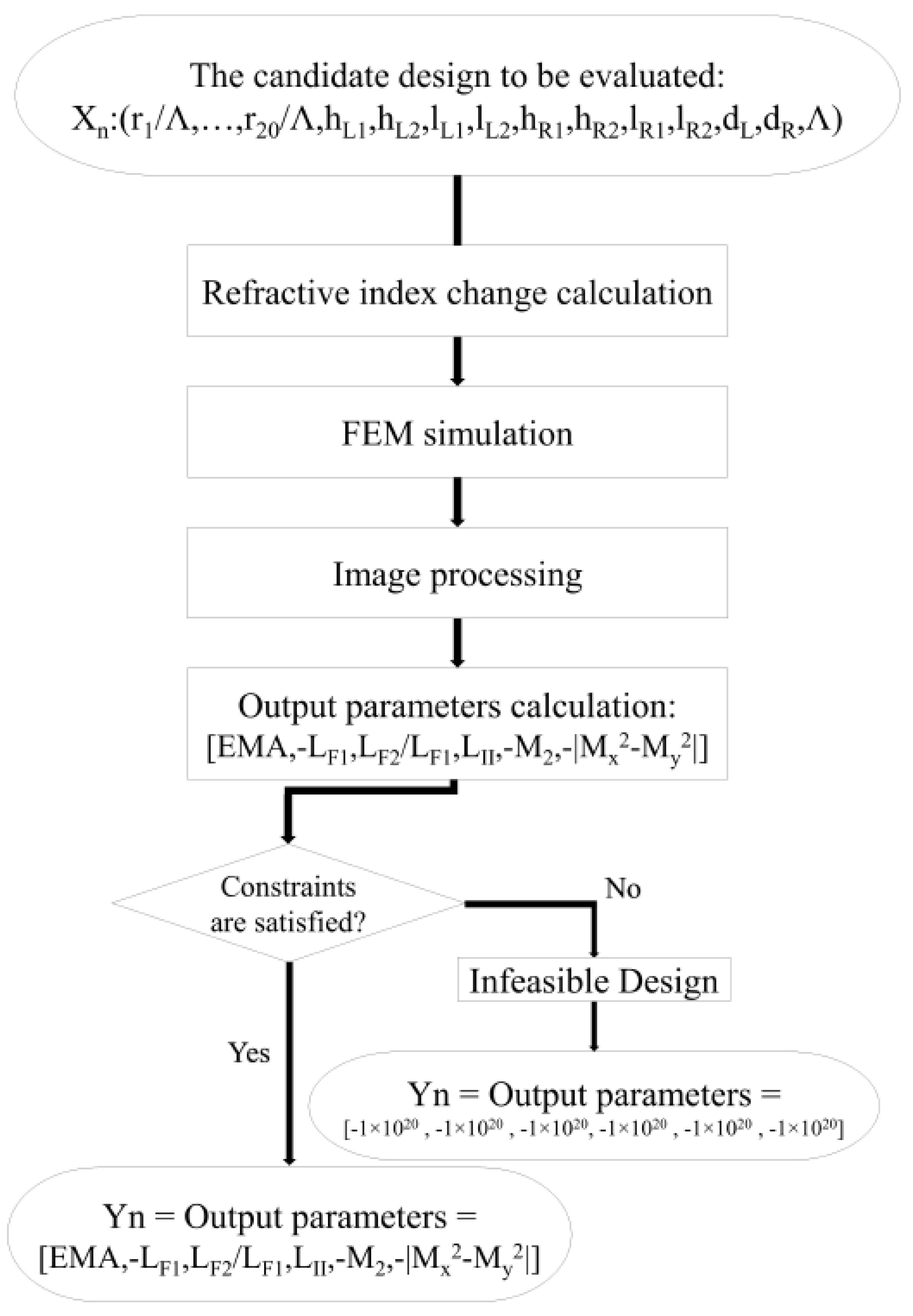



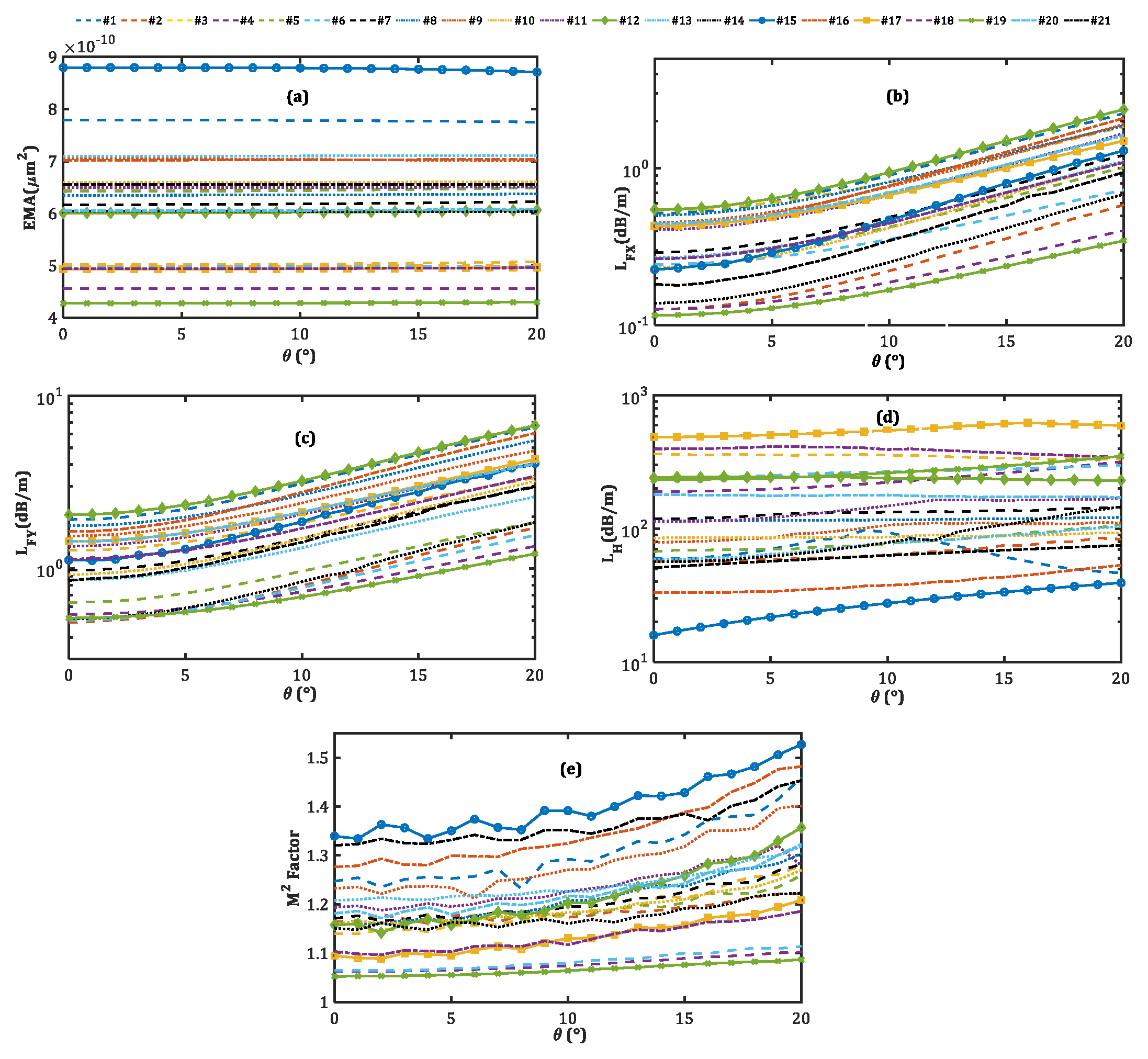
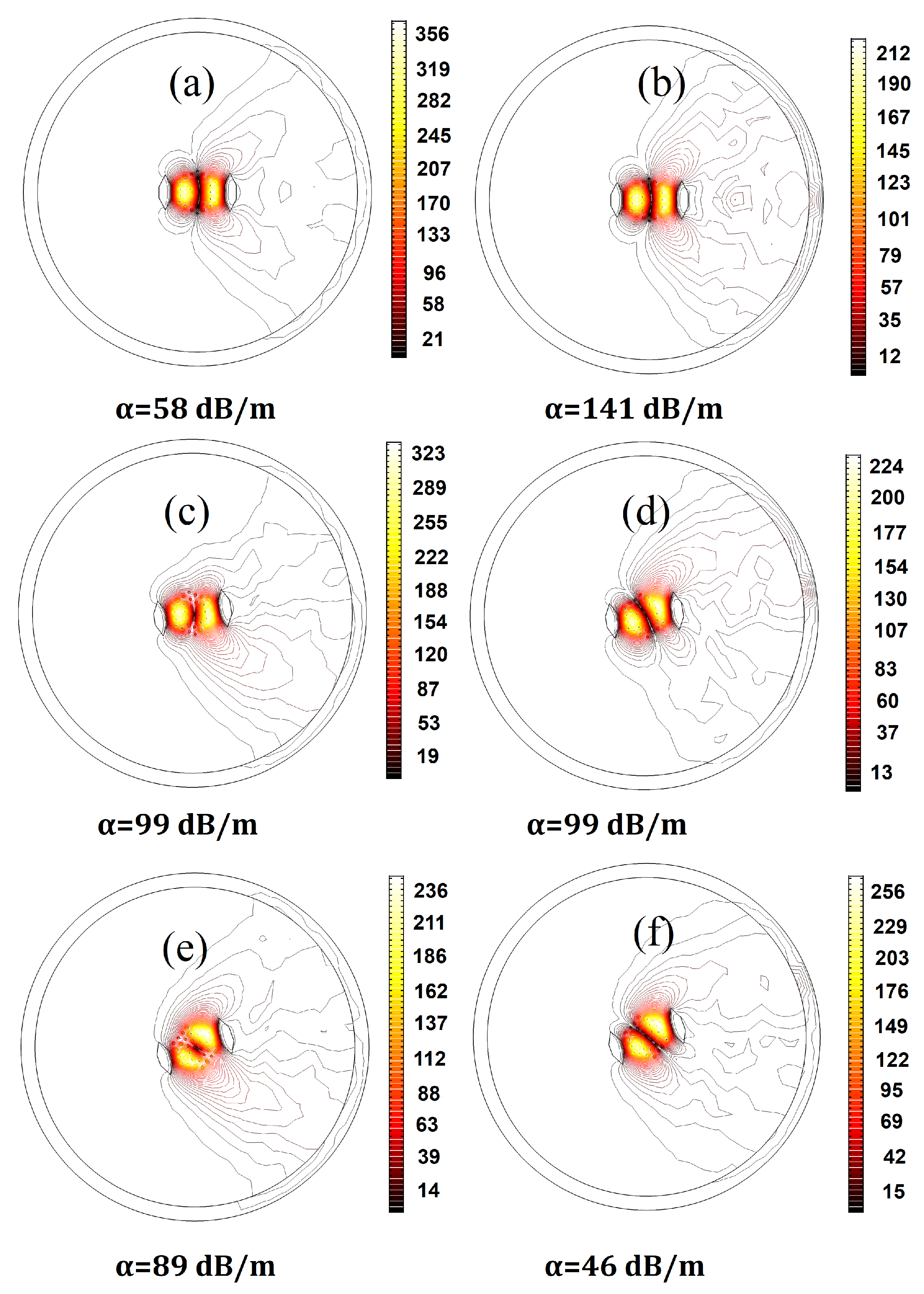
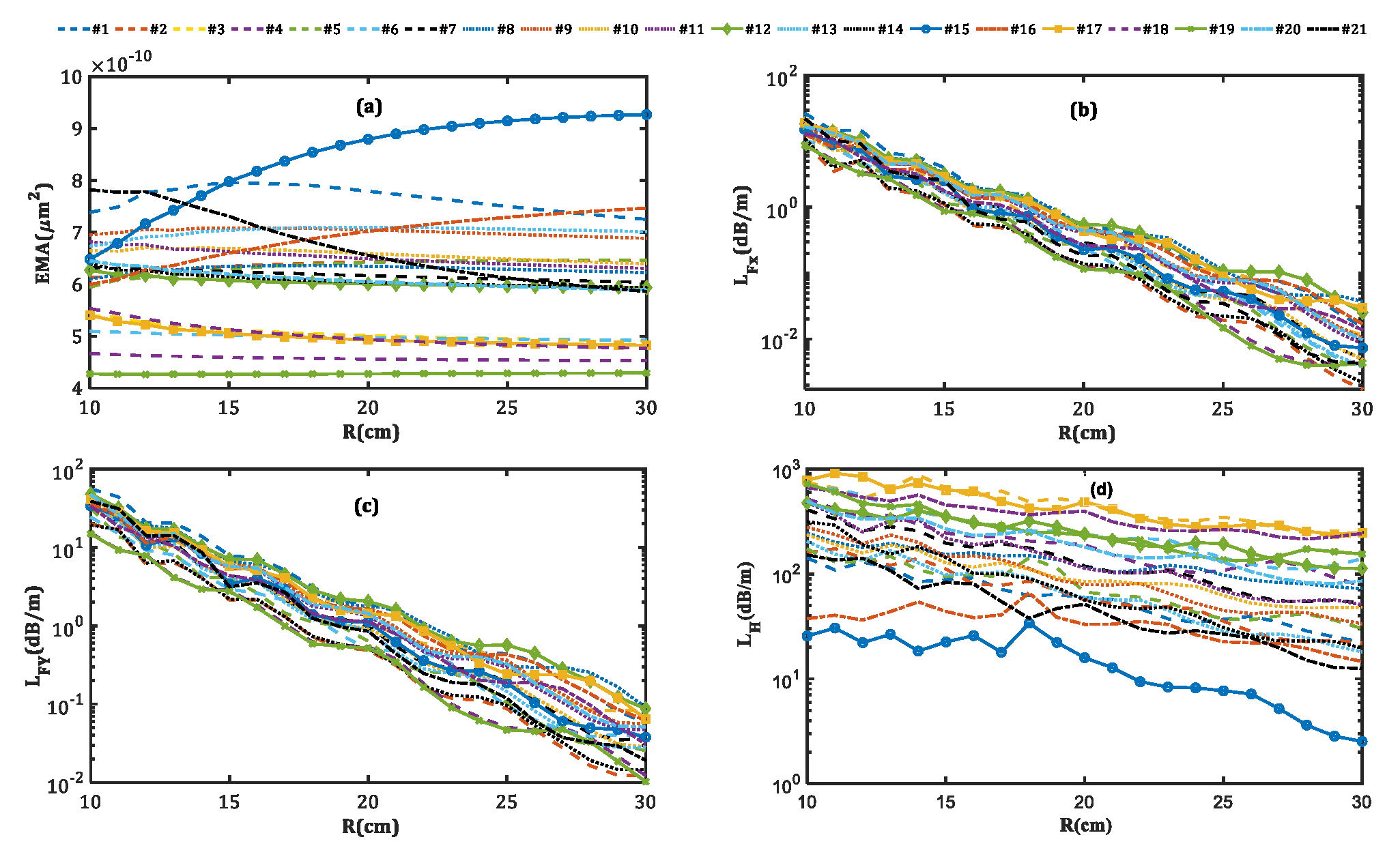
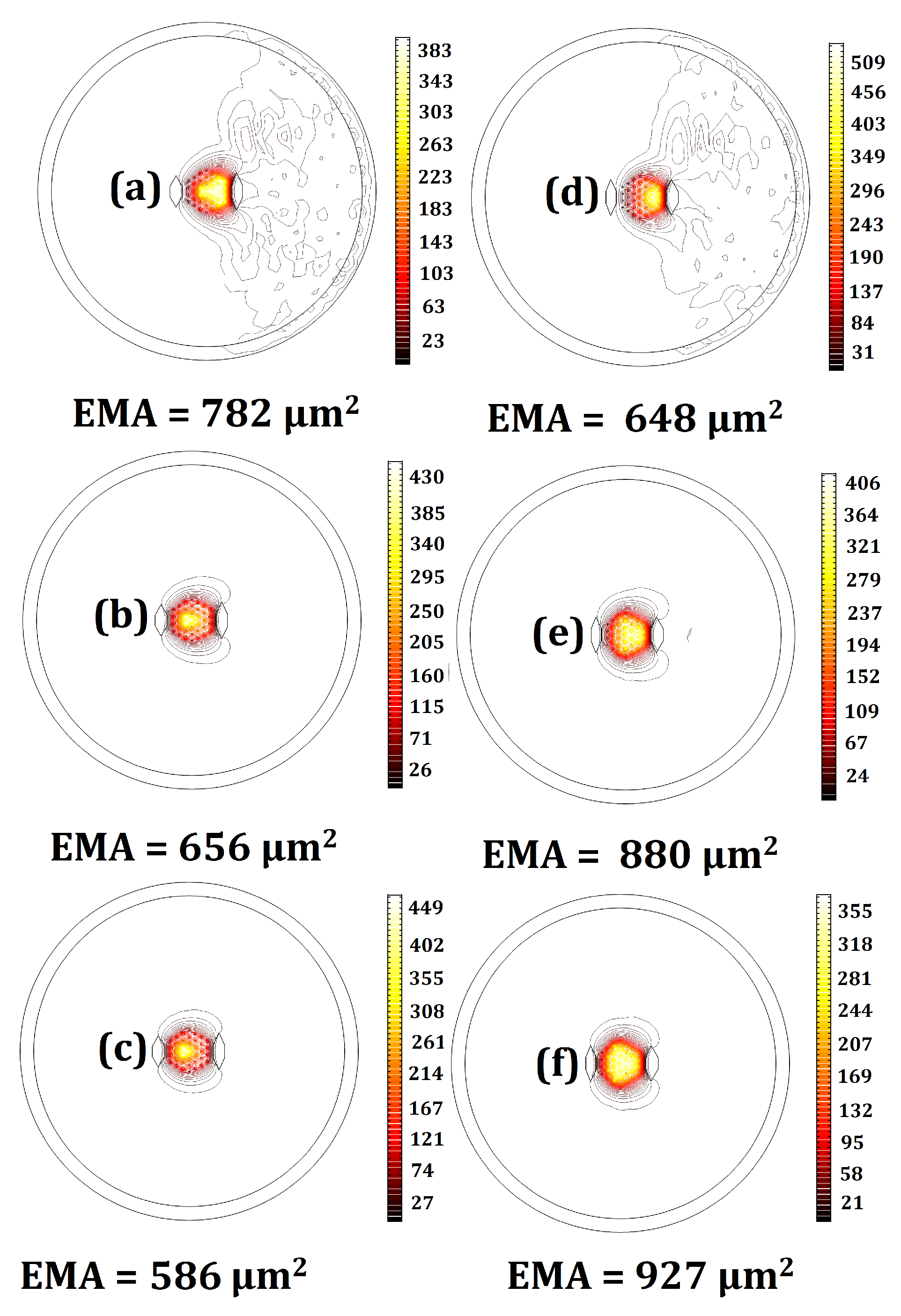
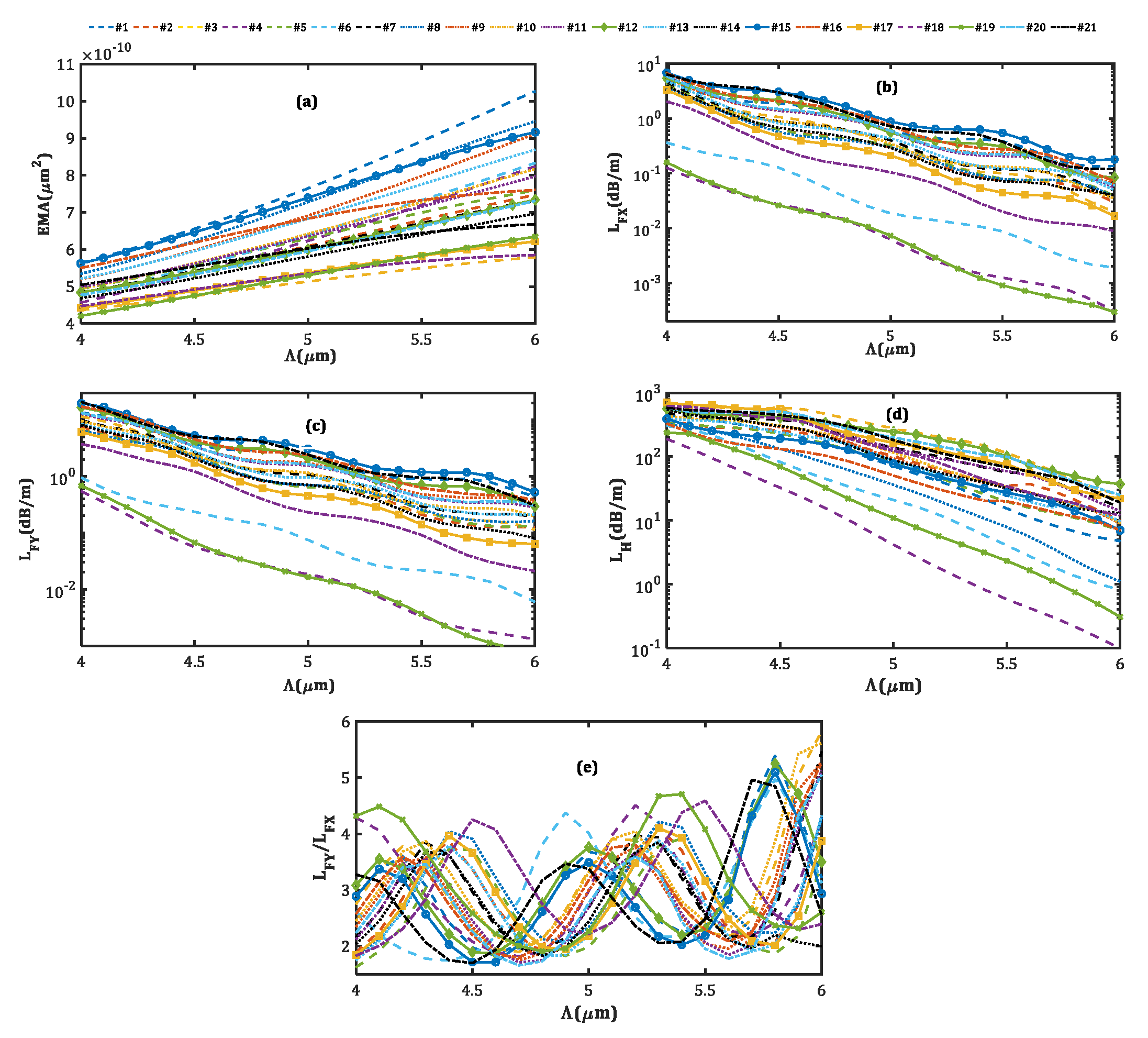
| Acronyms | Meaning | Acronyms | Meaning |
|---|---|---|---|
| SAPs | Stress-applying parts | LMA | Large-mode-area |
| FM | Fundamental mode | EMA | Effective Mode Area |
| HOMs | Higher-order modes | FOMs | Figure of merits |
| PCFs | Photonic-crystal fibers | LCFs | Leaky channel fibers |
| MCFs | Multicore fibers | SM | Single-mode |
| SP | Single-polarization | NA | Numerical aperture |
| FEM | Finite element method | PML | Perfectly matched layer |
| EMA | Effective mode area | CM | Constraint module |
| MOGWO | Multi-objective gray wolf optimizer | PM | Parameter module |
| Parameters | Min | Max |
|---|---|---|
| (m) | 4 | 10 |
| 0.1 | 0.4 | |
| 0 | 2 | |
| 0 | 1 | |
| −5 | −3.2 | |
| 3.2 | 5 | |
| (m) | 400 | - |
| (dB/m) | - | 0.6 |
| 2 | - | |
| (dB/m) | 15 | - |
| (dB/m) | 0.5 | - |
| 1 | 1.4 | |
| 0 | 0.2 |
Disclaimer/Publisher’s Note: The statements, opinions and data contained in all publications are solely those of the individual author(s) and contributor(s) and not of MDPI and/or the editor(s). MDPI and/or the editor(s) disclaim responsibility for any injury to people or property resulting from any ideas, methods, instructions or products referred to in the content. |
© 2023 by the authors. Licensee MDPI, Basel, Switzerland. This article is an open access article distributed under the terms and conditions of the Creative Commons Attribution (CC BY) license (https://creativecommons.org/licenses/by/4.0/).
Share and Cite
Rashidi, K.; Fathi, D.; Maleki, J.; Taleb, H.; Mirjalili, S.M.; Abbott, D. Design of Single-Mode Single-Polarization Large-Mode-Area Multicore Fibers. Micromachines 2023, 14, 1901. https://doi.org/10.3390/mi14101901
Rashidi K, Fathi D, Maleki J, Taleb H, Mirjalili SM, Abbott D. Design of Single-Mode Single-Polarization Large-Mode-Area Multicore Fibers. Micromachines. 2023; 14(10):1901. https://doi.org/10.3390/mi14101901
Chicago/Turabian StyleRashidi, Kamyar, Davood Fathi, Javad Maleki, Hussein Taleb, Seyed Mohammad Mirjalili, and Derek Abbott. 2023. "Design of Single-Mode Single-Polarization Large-Mode-Area Multicore Fibers" Micromachines 14, no. 10: 1901. https://doi.org/10.3390/mi14101901






